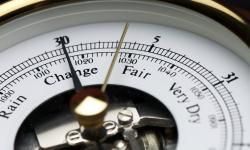A barometer measures air pressure: A "rising" barometer indicates increasing air pressure; a "falling" barometer indicates decreasing air pressure.
In space, there is a nearly complete vacuum so the air pressure is zero. On Earth, because there are many miles of air molecules stacked up and exerting pressure due to the force of gravity, the pressure is about 14.7 pounds per square inch at sea level (see this page for a good explanation of atmospheric pressure).
Advertisement
The interesting thing about air pressure is that it is different at different points on the planet and it changes over time. Why might that be? If you've read How Hot Air Balloons Work, you know that hot air is less dense (lighter) than cooler air. Therefore, on any given day you would expect the air over a desert to have a lower pressure than the air over an ice cap. And that would be true. These same sort of pressure differences occur all over the planet for various reasons.
These pressure differences have a big effect on the weather, so if you know the current air pressure at your house, as well as the pressure trend, you are able to predict certain things about the weather. As a very loose rule, a high-pressure area will be clear, and a low-pressure area will be cloudy and rainy.
Advertisement


